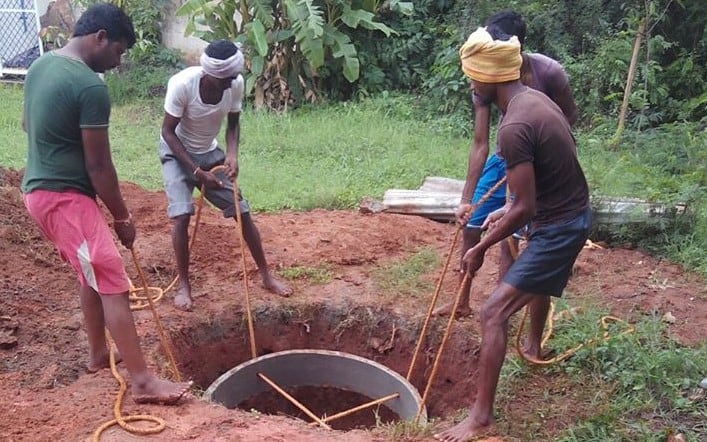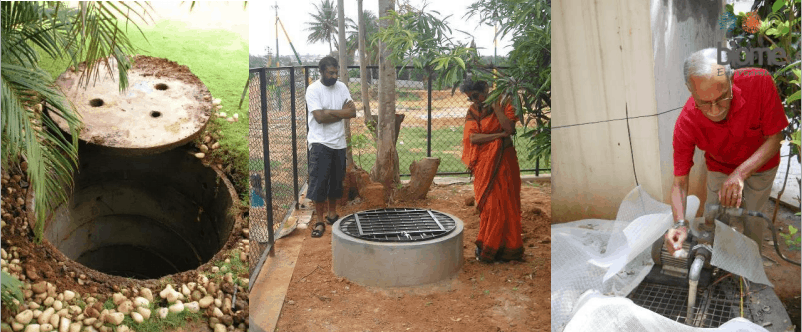
In 2018, Raghuram C G, a software program manager at Adobe, got a recharge well dug in his plot in Vidyaranyapura. “Rainwater falling in the plot gets channelised into the recharge well. The 15-ft well is now filled up to 10-11 ft, and has around 2000 litres of water. I’ve been building a house in the plot, and water from the well is used for all construction needs.” Raghuram built the well after being inspired by ‘A Million Wells for Bengaluru’ movement.
The design firm Biome Environmental Solutions, along with the non-profit India Cares Foundation and the citizen group Friends of Lakes, launched the Million Wells movement in 2018 to popularise rainwater harvesting (RWH). Since then, they have got over a lakh recharge wells dug in the city by coordinating with citizens, Resident Welfare Associations (RWAs), private industries, government agencies and NGOs. The campaign was received particularly well in water-starved areas.
| Why recharge wells? The concept behind recharge wells is that water collected in these wells during rains would percolate into the ground and recharge shallow aquifers. Shallow aquifers are water-bearing formations that exist about 10-100 ft underground. These are supposed to get replenished naturally during rains, but water percolation tends to be low in urban built-up spaces. Hence, with recharge wells, rainwater can be routed into the shallow aquifers, which would enhance groundwater levels. |
Read: Guide to digging a recharge well
S Vishwanath, Director at Biome, also popularly known as ‘Rainman’, says, “Quite frankly we don’t have an exact count, but approximately 1.2 lakh recharge wells have been dug so far.” Of these, the majority – 72,000 – were dug in 2019.
Vishwanath said it was a 2018 report by NITI Ayog that created a “critical unrest” among citizens and government agencies over Bengaluru’s extremely low groundwater levels. The report had warned that Bengaluru was inching closer to ‘Day Zero’ – that the city would have no water unless it took serious measures for conservation.
“We then decided that we should take some action, both to create awareness and to demonstrate measures to tackle water shortage,” Vishwanath said.
As per the MoU signed for the project,
- Friends of Lakes is the Implementation Partner. They organise voluntary community engagements to clean the city’s lakes.
- India Cares Foundation is the Enabler that takes care of fundraising.
- Biome is the Technical Partner that supports the project through consultations by architects, civil and mechanical engineers, urban planners.
Citizens take up the cause
Ramprasad V, co-founder of Friends of Lakes, said their intensive effort is paying dividends as more RWAs and independent households have been adopting RWH. According to Ramprasad, RWAs in water-starved Bellandur are now targeting to dig about 2,500 recharge wells. In Malleshwaram, about 2000 recharge wells have already been dug, he says.
Though the concept of RWH has been around in the city for over a decade, Vishwanath said, “post coining the term ‘Million Wells’, there was more dialogue around RWH, and people took upon themselves to create recharge wells so as to replenish the depleting groundwater table.”

To dig the wells, the movement engaged around 750 people from the Bovi community who are traditional well-diggers. Also, awareness programmes were held to apprise RWAs and individuals of the need to dig recharge wells in compliance with BWSSB bylaws.
Seema Sharma, an IT Professional and a resident of Mantri Espana in Bellandur, is a volunteer with Million Wells. She said that seven recharge wells have been dug at Mantri Espana as part of the movement, with a long-term vision to improve the groundwater table. “A lot of rainwater is directed to these recharge pits, though we may not see an immediate impact. This has also reduced waterlogging in the area.”
| 77 recharge wells built in Cubbon Park alone Ramprasad says that under the movement, volunteers have dug 77 recharge wells in Cubbon Park alone. These were dug in spots that used to get waterlogged. He says, “Now waterlogging has stopped, and people are able to reclaim spaces that were previously unusable. Water levels have risen in the newly-dug recharge wells, and this water is used for the park’s needs. We are showing the Cubbon Park success as a Proof of Concept. It gives the message that public spaces can be used to recharge groundwater.” |
Coordinators of ‘Million Wells’ movement also point out that the groundwater levels in IIM-B has increased with recharge wells. As per the IIM-B website, around 20% of water requirements in the campus is now met through recharge wells/RWH measures.
Data, protection of shallow aquifers needed
Ramprasad points out that post-rain, people conveniently forget they have to focus on RWH. “Also, some areas in the city may not be conducive for recharge wells because of hard rock or clay layers. But to decide if wells are feasible in those areas, appropriate mapping is not available with civic agencies. If GIS (Geographic Information System) or remote sensing data was available, we’d have better understanding of geological features such as land cover, drainage and the locations where recharge wells are feasible,” he says.
In addition to mapping, the city’s Master Plan and building bye-laws should have provisions to protect shallow aquifers, says Vishwanath. He explains why, “In places such as New Mount Carmel or near HMT at Mekhri Circle, upcoming projects – especially buildings with parking basements – destroy the shallow aquifer. They pump out groundwater into stormwater drains, depleting the whole area of groundwater.”
Long way to go
The movement is still a long way away from reaching its target of channeling half the rainwater Bengaluru receives, into recharge pits.
Now, in association with Rotary Club Bengaluru, they are planning to convince over 6000 industries in Peenya Industrial Area to set up recharge wells. According to them, years of unchecked release of chemical effluents have already contaminated groundwater there.
Ramprasad said, “We will ask companies to meet the basic minimum law pertaining to RWH. Hopefully, if the rainwater there is channelised appropriately into recharge wells, this may dilute the contamination in 15 to 20 years.”
Vishwanath said that several organisations have taken initiative to set up recharge wells themselves. For instance, on March 11, the NGO United Ways Bengaluru said they had installed around 50 recharge wells, with the capacity to hold 2.3 lakh litres of water, in Lalbagh Gardens. The NGO tweeted, “But our goal is to aim for 500 percolation wells which have the potential to capture 115 million liters of rainwater in total. So, 450 more to go.”
With more recharge wells being dug in the city, coordinators of Million Wells movement hope Bengalureans would be able to tide over harsh, water-stressed summers. They caution that unless citizens put in some effort to replenish the water they consume, uninterrupted water supply in Bengaluru will remain a pipe dream.
Can you please send details so that we can start the same in uttarpradesh
Doddanekkundi lake is a total mess. Government and leaders arnt bothering inspite of several requests. Could you help rejuvenate.
Can u share contact details of Mr.Viswanath of Biome Environmental Solutions
Need Biome Env contact number